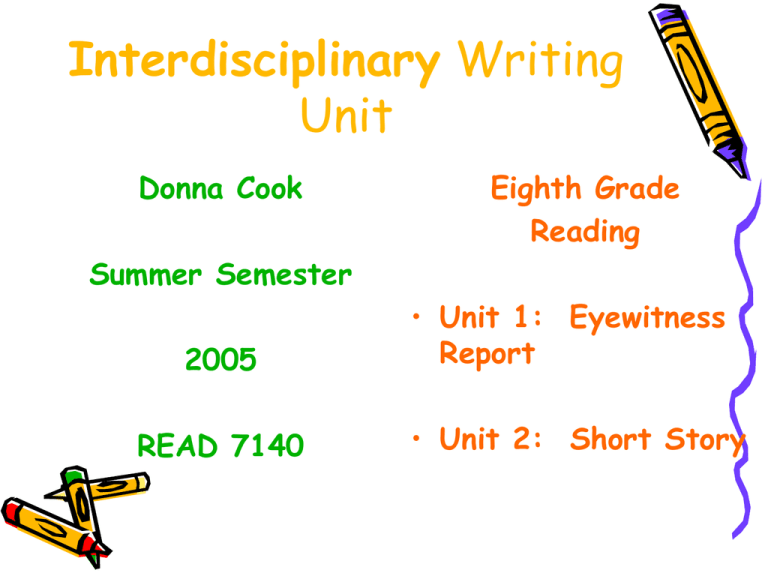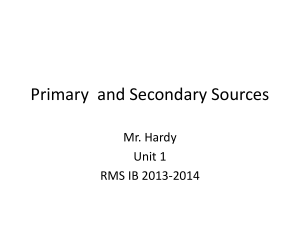Cook, Donna
advertisement

Interdisciplinary Writing Unit Donna Cook Eighth Grade Reading Summer Semester 2005 READ 7140 • Unit 1: Eyewitness Report • Unit 2: Short Story Georgia Performance Standards ELA GPS K-3 (Handout) ELA GPS 4-8 (Handout) Writing Across the Curriculum www.doe.k12.ga.us Introduction to Unit • Parent/Student Letter • Analytic and Holistic Scoring • Middle Grades Writing Assignment Rubric • Define – Expository Writing Eyewitness Report • Teacher Skit Middle Grades Writing Assessment 8th Grade • • • • Analytic and Holistic Scoring The scoring system is analytic. Analytic scoring means that more than one feature or domain of paper is evaluated. Each domain itself is scored holistically. The score assigned indicates the test raters’ overall impression of the writer’s command of the components, using predetermined scoring criteria contained in the Scoring Rubrics. Accurate scoring requires balancing a writer’s strengths and weaknesses. Domain Weighting Each paper is scored in five domains: Content/Organization, Style, Sentence Formation, Usage, and Mechanics. Scores in each domain range from 1 to 4 (4 being the highest score). The total weighted raw scores range from 16 (1’s in all four domains) to 64 (4’s in all four domains). Domain Domain Weight Calculation of Weighted Score 37.5% 3 x each rater’s score 25% 2 x each rater’s score Sentence Formation (SF) 12.5 % 1 x each rater’s score Usage (U) 12.5% 1 x each rater’s score Mechanics (M) 12.5% 1 x each rater’s score Content/ Organization C/O Style (S) Rubric: http://www.doe.k12.ga.us/curriculum/testing/writing.asp Unit 1: Eyewitness Report Prewriting • 5-How Graphic Organizer • Eyewitness Report At a Glance • Idea Bank • Including Quotations • 5-W-How Graphic Organizer Scoring Guide NAME: __Donna Cook_________ DATE:___6/16/06 Event: _________Argument prior to class_________ 5-W-How Graphic Organizer (Completed for Modeling Exercise) WHO? Two teachers (or a teacher and a student) WHAT? An argument about something the principal said WHERE? In our classroom WHEN? At the beginning of this class WHY? Mr. ________ told Ms. __________ to give our teacher a message about something we were supposed to do in class. HOW? She came into our classroom and very loudly told Ms. ___________ to do something. EYE WITNESS REPORT AT A GLANCE (TRANSPARENCY #1) WHO? People involved HOW? The details WHAT? THE EVENT RUBRIC Standards for Writing A successful eyewitness report should: • Re-creation Of events WHERE? The place WHY? cause • • WHEN? Date, time, year • • • • • Focus on an event that is important to the writer or is historically important. Answer the five W’s: who, what, when, where, and why Explain how the event occurred. Use sensory details, dialogue, and action verbs to show exactly what the writer observed Present events in a clear, logical order (Writing Workshop: Eyewitness Report) Idea Bank (Transparency #2) Finding a Topic Look for Puzzles. Think about something you have seen that puzzles you. You could describe what you saw and what it left you wondering. What’s New? Think about something new in your life. You might describe a day in the life of a new baby brother or sister or a new pet. You might describe your first outing in a new family car or your first experience with a new computer. Take a Walk. Describe something that catches your interest on a walk, either in your neighborhood or something unfamiliar. Check your calendar. Does the future hold a sports event, club event, or family gathering? Plan to attend and take notes. (Writing Workshop: Eyewitness Report) Including Quotations (Transparency #3) Find another witness. Quote another person who saw the same thing you did. The quotation might support your view or contrast with it. Quote an expert. Cite the words of an expert on the topic. Be Creative. Provide a literary quotation or song lyrics to illustrate the point of your report. (Writing Workshop: Eyewitness Report) 5-W-How Graphic Organizer Scoring Guide Prewriting Assessment Student Name: ______________________________________ Date: ____________ Question Teacher comments on answers Possible Points Event 16 Who? 14 What? 14 Where? 14 When? 14 Why? 14 How? 14 Points Received Drafting: •Transition Tool Box •Getting Organized •Sample Eyewitness Report Organizing (transparency #4) Sequential Order Used in short stories, news reports, “how-to” manuals, biographies, science and history writing. Example: To make a print from a mushroom sport, first cut off the mushroom’s cap. Then place the cap on a piece of paper for two hours. Spatial Order Used in science writing, mysteries, eyewitness accounts, short stories Example: The cauliflower fungus grows on the roots of pine trees, very close to the base of the tree’s trunk. Cause-and-Effect Order Used in science and history writing, editorials, persuasive writing Example: As a result of the increased use of pesticides and fertilizers, field mushrooms have become much less common. Compare-and-Contrast Order Used in book reviews, encyclopedias, consumer guides Example: The dirty trich and the sticky gray trich mushrooms are members of the same species. They are similar in size. The sticky gray trich can be eaten, but the dirty trich is poisonous. Order of Degree Used in persuasive writing, editorials, reference books, advertisements Example: The lawn mower’s mushroom is a familiar mushroom. The giant puffball is more unusual. However, the stinky squid is very rare (Writing Workshop: Eyewitness Report). TRANSITION TOOL BOX Words and Phrases that link (TRANSPARENCY #5) COMPARE AS ALSO IN THE SAME WAY LIKE LIKEWISE SIMILARLY CONTRAST BUT HOWEVER IN CONTRAST INSTEAD ON THE OTHER HAND UNLIKE SEQUENTIAL ORDER NEXT THEN DURING LAST LATER ONCE SPATIAL ORDER AROUND BELOW CENTER IN FRONT OF OUTSIDE SURROUNDING TO THE LEFT TO THE RIGHT CAUSE-ANDEFFECT ORDER AS A RESULT BECAUSE CAUSED BY CONSEQUENTLY DUE TO FOR THIS REASON IF . . . THEN ORDER OF DEGREE EVEN LESS EVEN MORE FINALLY FIRST FROM . . . TO FURTHERMORE LEAST MOST TO (Writing Workshop: Eyewitness Report) Rubric in Action The Perfect Performance Only a few hours ago, I was inside the U.T. Tyler auditorium watching a wonderful presentation put on by the talented, exotic National Acrobats of China. The performance I saw included a man executing acrobatics on top of a 15-foot tower of chairs. At the beginning of the performance, a man brought out a tall, four-legged, stool-type platform. It had a blue cape around the perimeter that seemed to be made of crushed velvet and was decorated in blue and gold. Another man brought in four wine bottles, which he tapped to demonstrate that they were really made out of glass. He then placed the bottles on each of the four corners of the stool, and on top of the bottles, he placed a chair with its legs resting on the bottles. The men would place many other chairs on top of their chair throughout the course of the performance. These chairs were plain white with blue trim, and their backs were straight and vertical, with no curve. To the very tiptop of this lofty tower of chairs went an acrobat dressed in silken clothes of blue and white. Great suspense grew among the audience as the men on the stage thrust yet another chair into the air for him. The performer, however, knew exactly what he was doing. Though he laughed and smiled for the audience, he was dead serious. Catching the chair, he placed it on the top chair and tilted it diagonally, so that just two of its legs touched the rest of the tower. The audience was silent in awe as he did a handstand on the tilted chair and then spun around, using only one arm to hold his limber body in midair over the chair. For a finale, the acrobat added three more chairs, and he stood on his head at the very top. As he was doing this, the chairs shook. I was secretly scared, but he came out all right. Last, as he climbed down, he threw the chairs down one by one to the three other performers on the stage. When the tower of chairs was completely demolished, he leaped into the air and did a dizzying somersault to the ground, landing perfectly. 1. Begins by telling when, who, where, and what about the event. 2. Uses sensory details of sight and sound. 3. Captures the mood of the event. 4. Presents events in a clear logical order. (Writing Workshop: Eyewitness Report) Getting Organized (transparency #6) to be used with modeling activity Event: Performance of the Chinese National Acrobats First Event: A man brought out a four legged, stool-type platform. Second Event: Third Event: Fourth Event: An acrobat climbed to the very top of this whole conglomeration of chairs! The acrobat added three more chairs, and stood on his head at the very top. Afterward, he very carefully climbed down disassembling the chairs as he went. Another man brought in four wine bottles and placed them at the four corners of the stool. Then he placed a chair with its legs resting on the bottles. The men placed many chairs on top of that chair. Name of eyewitness Author:___________________________________________________ Name of peer editor:_____________________________________ Friendly Feedback Peer Editing Worksheet: All questions should be answered completely. REMEMBER – DO NOT WRITE ON THE ORIGINAL PAPER! 1. What did I describe and when did it take place? 2. What mood did I create? 3. What details helped you experience the event? 4. How did I show the order of events? 5. What did you like best about my report? Eyewitness Report DRAFTING SCORING GUIDE Author Name: ________________________________Date: ____________ Completed “Friendly Feedback” Worksheet is attached: __________ Question Teacher comments Possible Points Focused on an event that has personal or historical meaning? 20 Answered the five W’s: who, what, when, where, and why? 20 Used precise language and sensory images? 20 Presented what happened in a clear, logical order? 20 Captured the mood of the event? 20 Total Points 100 Points Received Revising/Proofreading/Editing Friendly Feedback + Drafting Scoring Guide + “The Six Traits of Good Writing” = A+ Eyewitness Report Six Traits of Good Writing (Transparency #8) 1. Ideas and Content Ideas are clear, focused, and well supported with relevant details. 2. Organization Ideas are arranged in a logical order that moves the reader through the text. 3. Voice The writing shows individual style and personality. 4. Word Choice Language is precise, powerful, and engaging. 5. Sentence Fluency Writing has a pleasing rhythm and flow, and shows varied sentence length and structure. 6. Conventions Grammar, spelling, and punctuation errors are eliminated. (Writing Workshop: Eyewitness Report) Publication! Header/Footer Save under student name 12 Pt. Times New Roman Font Use grammar and spell check YOU ARE FINISHED! Modifications/Accommodations • Georgia Learning Connection website at www.glc.k12.ga.us/password/trc Grouping: Prewriting: Students work cooperatively in groups of two to four. Drafting: Students work cooperatively in groups of two to four. Revising/Proofreading/Editing: Students work cooperatively in groups of two to four. Publishing: Students work individually. NOTE: Grouping strategies may vary depending on the needs of the individuals in the class. • • • • Prewriting Drafting Revising/Proofreading/Editing Publication References • Georgia Department of Education (2005). Writing assessments. Retrieved June 25, 2005 from http://www.doe.k12.ga.us/curriculum/testing/writing.asp. • Georgia School Council Institute (2005). Retrieved June 25, 2005 from http://www.gaschoolcouncil.org/index.html. • “Writing workshop: Eyewitness report.” In Language network: Grammar, writing,communication (432439).(2003). Evanston, IL: McDougal Littell Inc.






